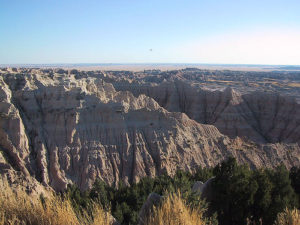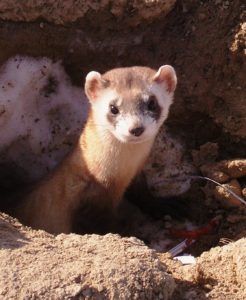Native Americans called the place the “bad lands” because traveling through the landscape was so difficult. The name stuck as ranchers, farmers and other settlers attempted to carve a living from the land. Perhaps the best use of the region was settled when it was declared a national monument on January 25, 1939, by President Franklin Roosevelt.
The badlands region of southwestern South Dakota served as home to several Native American groups for as long as 11,000 years. Their descendants were the Lakota Indians who still live in the region. Most Native American lands were appropriated by the federal government for granting to homesteaders in the late 1800s. Conflicts began, including the famous battle at Wounded Knee (which is not in the park itself, but about 45 miles south).

After the turn of the century, homesteading began in earnest. Changes in federal law expanded the size of a homestead from the traditional 160 acres to 640 acres, acknowledging the inability of a small tract to support a family. Life was hard, with dry summers, brutally cold winters and strong winds at all times. During the Dust Bowl years, farming became so difficult that most families abandoned their lands or sold them back to the federal government.
During this time, the idea of preserving the lands gained attention. In various stages, plans for a national park or monument were developed and passed. The creation of a park was pushed most vigorously by South Dakota Senator Peter Norbeck, also known for his commitment to wildlife and waterfowl in particular. The Badlands National Monument was officially created by the proclamation of President Roosevelt on January 25, 1939 (later, in 1978, the monument was reclassified as Badlands National Park).
The park covers approximately 240,000 acres of highly eroded hills surrounded by a mixed-grass prairie ecosystem. The area was covered by an ancient sea that disappeared gradually, depositing sediments until about 28 million years ago. Because of this history, Badlands contains exceptional fossil beds, serving as the nation’s most productive site for mammalian fossils from the Oligocene.
The early arguments over whether Badlands should be a national park or monument revolved around access for recreational visitors—it was a hard place to get to. Today, however, it has become a popular site. From a low of about 10,000 annual visitors during World War II, annual visitation is now around 1 million.

The park is notable for a fauna that is well adapted to life in such harsh conditions. Although both American bison and pronghorn antelope were extirpated, they have been reintroduced and are thriving. Of particular interest is the endangered black-footed ferret, which has suffered because of habitat loss, declines in their prey (especially prairie dogs), and disease. Populations have been re-introduced into Badlands National Park as part of the recovery plan that is based entirely on captive breeding and establishment of carefully protected populations.
References:
Mattison, Ray H. and Robert A. Grom. 1968. History of Badlands National Monument. Badlands Natural History Association. Available at: https://www.nps.gov/parkhistory/online_books/badl/index.htm. Accessed January 24, 2018.
National Park Service. Badlands. Available at: https://www.nps.gov/badl/learn/nature/mammals.htm. Accessed January 24, 2018.
US-Parks.com. Badlands National Park History. Available at: http://www.us-parks.com/badlands-national-park/history.html. Accessed January 24, 2018.
